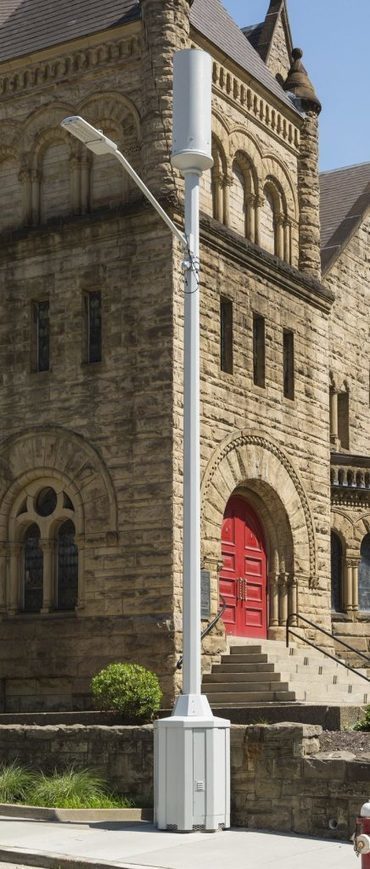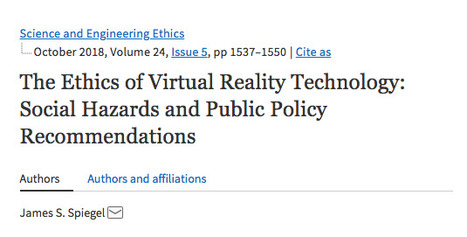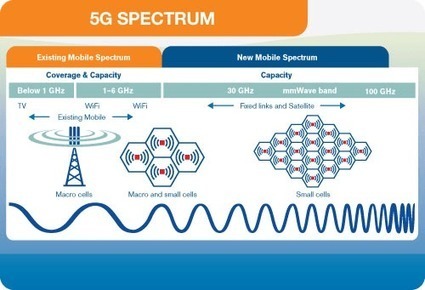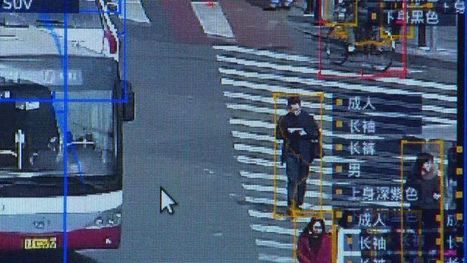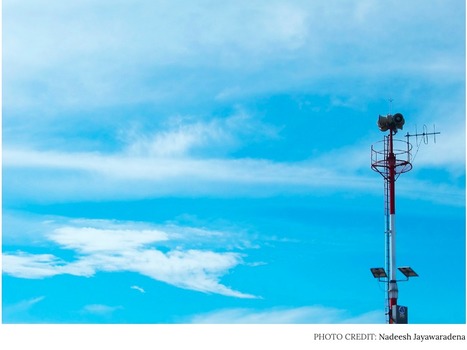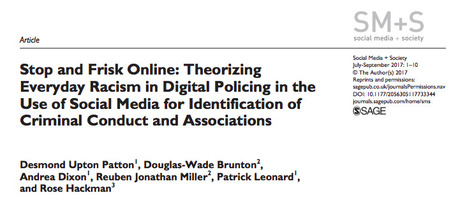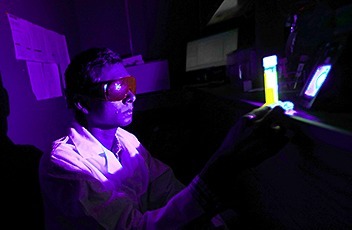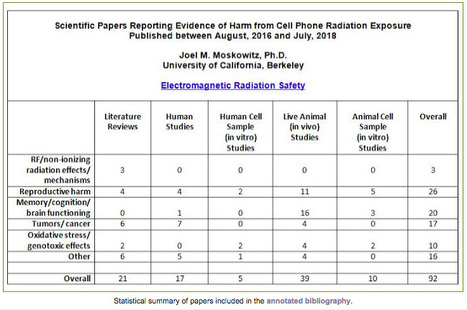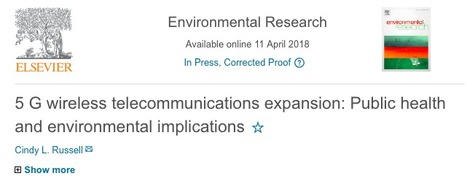To download, click on title or arrow above. Slides are also available at: http://bit.ly/UCB2-27-19jmm
Get Started for FREE
Sign up with Facebook Sign up with X
I don't have a Facebook or a X account

 Your new post is loading... Your new post is loading...
 Your new post is loading... Your new post is loading...
By Vince Rotty On September 27, 2018, the FCC released a declaratory ruling and report and order (available here). This post has been updated to reflect the FCC’s new regulations.
I. WHAT ARE SMALL WIRELESS FACILITIES? A small wireless facility (sometimes referred to as a small cell facility) is a cellular network facility capable of delivering high transmission speeds but at lower ranges. Although they are called “small,” this is in reference to their small coverage area, not their physical size. These facilities, due to their heightened transmission speeds and capacities, are critical to the wireless industry’s deployment of 5G services. However, because a small wireless facility, when compared to a traditional macrocell tower, is only able to transmit data at low ranges and is not capable of transmitting through buildings and other structures, many more small wireless facilities are needed to cover the same geographic area that a single, traditional macrocell tower would cover. It is estimated that each wireless provider will need at least ten times as many small wireless facilities as macrocell towers to provide the same network coverage.[1]
II. WHY ARE SMALL WIRELESS FACILITIES IN THE PUBLIC RIGHTS-OF-WAY? Wireless service providers and wireless infrastructure providers will seek to collocate small wireless facilities and construct wireless support structures in a municipality’s rights-of-ways for a number of reasons, but one of the primary reasons is that small wireless facilities require two resources: (1) data via fiber optic cable and (2) power, and both of these resources are often found in a municipality’s rights-of-way. Additionally, many states have enacted statutes that, among other things, limit rights-of-way and permit application fees that a municipality can collect from a wireless service provider or wireless infrastructure provider and create statutory review periods for small wireless facility permit applications.[2] Often, utility poles and wireless support structures owned by private entities are exempt from these state statutes, further prompting wireless providers and wireless infrastructure providers to prefer to collocate small wireless facilities to existing municipal assets in the municipality’s rights-of-way.[3] III. WHICH TYPES OF ENTITIES ARE COLLOCATING SMALL WIRELESS FACILITIES OR CONSTRUCTING WIRELESS SUPPORT STRUCTURES? In addition to traditional wireless providers, neutral host and other infrastructure providers are also expected to play a critical role in the deployment of small wireless facilities. Neutral host and other infrastructure providers will often lease their wireless assets to traditional wireless providers. As a result, your municipality might not receive any permit requests of applications for collocating small wireless facilities or constructing wireless support structures from traditional wireless providers such as AT&T, Verizon, T-Mobile, and Sprint. Instead, your municipality may be receiving permit requests and applications from neutral host providers such as ExteNet and Mobilitie. IV. WHY SHOULD MY MUNICIPALITY BE CONCERNED? Not all small wireless facilities are created equal. While wireless providers and wireless infrastructure providers may initially propose to construct facilities that are integrated into light poles, monopoles, traffic signals, and other existing rights-of-way structures or assets, the reality is that your municipality should expect that very few small wireless facilities will be constructed in this manner. For example, a light pole with a pole-top antenna and integrated equipment cabinet is shown below. As can be seen in the below image, there are almost no exposed elements or cables, and there is only a minimal intrusion into the rights-of-way. The rights-of-way in the below image appears to be largely undisturbed by the small wireless facility integrated into the light pole.
Source: https://twitter.com/stealthsite/status/851882939633762304 However, in reality, many small wireless facilities are likely to be collocated on existing wooden utility poles. Because these existing utility poles are almost universally incapable of integrating equipment cabinets within the pole’s base, as is in the above image, wireless service providers and wireless infrastructure providers will instead install equipment cabinets at ground level or mount the cabinets to utility poles in the rights-of-way. These facilities can create safety, aesthetic, and noise issues, including violations of the Americans with Disabilities Act of 1990 (“the ADA”). An example of a non-integrated small wireless facility is shown below. As can be seen in the below image, the small wireless facility extends beyond the wooden utility pole, the cabling is loose, and there are equipment cabinets mounted at the top of the pole.
Source: https://www.cleveland.com/middleburg-heights/index.ssf/2018/05/middleburg_will_closely_regula.html These rights-of-way impacts and concerns are compounded by the increased number of small wireless facilities necessary to operate a small cell network. Regulating how and when small wireless facilities can be collocated in your municipality’s rights-of-way is key to addressing a municipality’s concerns such as safety, noise, aesthetic, and undergrounding of ground-level facilities. V. HOW SHOULD MY MUNICIPALITY RESPOND TO REQUESTS TO COLLOCATE SMALL WIRELESS FACILITIES OR CONSTRUCT WIRELESS SUPPORT STRUCTURES IN ITS PUBLIC RIGHTS-OF-WAY? When a municipality receives a permit request or application to collocate a small wireless facility or construct a wireless support structure, there are three sources of law that must be followed: (1) federal law, (2) state law, and (3) local law. A. Federal LawIn 2018, the FCC issued a declaratory ruling and report and order addressing how municipalities must process small wireless facility applications.[4] A small wireless facility application is an application for a permit or other authorization that seeks to either: (1) collocate a small wireless facility on an existing structure or (2) collocate a small wireless facility on a new structure (i.e., construction of a new structure to collocate a small wireless facility).[5] The primary difference between these two types of small wireless facility applications is the number of days that a municipality is allowed to process the application (shown below). Type of Permit Request Review Period Remedy Collocation on an existing structure 60 days Judicial Cause of Action Collocation on a new structure 90 days Judicial Cause of Action If a municipality fails to grant or deny an application within either of these review periods, the applicant may appeal the municipality’s failure to act to an applicable court.[6] Unlike Section 6409(a) applications, there is no deemed granted remedy for small wireless facility applications.[7] A deemed granted remedy means that an application is automatically granted if a municipality fails to act on the application. For more information on the details and impacts of federal law, please consult your legal counsel or the attorneys at Bradley Berkland Hagen & Herbst LLC. B. State LawAfter determining how to process a permit application or request under federal law, a municipality should next examine their state law. Often, state small wireless facility statutes will reduce review periods, limit the criteria by which a permit can be denied, and limit fees that municipalities can charge. A list of states that have passed small wireless facility laws can be found here. In short, state small wireless facility statutes are rarely, if ever, helpful for local governments. Instead, these statutes almost invariably limit municipal authority. For example, Oklahoma’s small wireless facility statute reduces the 90-day review period in federal law to 75-days and limits fees to $40 per small wireless facility collocated on a municipally-owned utility pole in the rights-of-way.[8] If your state has enacted a small wireless facility statute, it will be important to understand the restrictions and limitations placed on your municipality by state law in addition to federal law. If your municipality is in a state that hasn’t passed small wireless facility-specific legislation, your municipality should nevertheless look for any processes or requirements that apply generally to wireless towers. These statutes were likely enacted with macrocell towers in mind but are often applicable to small wireless facilities. C. Local LawFinally, your municipality should examine its local law to determine how to process an application. Many municipalities have passed ordinances governing the municipality’s rights-of-way or wireless towers, but some municipalities have passed small wireless facility ordinances as well. While no small wireless facility ordinance “may prohibit or have the effect of prohibiting the ability of any entity to provide any interstate or intrastate telecommunications service” (i.e., a prohibition on the collocation of small wireless facilities within a municipality), these ordinances do allow a municipality to enact aesthetic and design standards, undergrounding requirements, and other zoning restrictions.[9] If your municipality has not already enacted a small wireless facility ordinance, please speak with an attorney at Bradley Berkland Hagen & Herbst to discuss how your community’s unique needs and interests can be addressed through an ordinance or other legal mechanisms."
For original post, please see:
Abstract
By IIshana Artra "In recent months there’s been a lot of talk about 5G – the next generation of wireless technology. 5G is being touted as a necessary step to the ‘internet of things’ – a world in which our refrigerators alert us when we’re low on milk, our baby’s diapers tell us when they need to be changed, and Netflix is available everywhere, all the time. But what we’re not hearing is that evidence-based studies worldwide have clearly established the harmful effects of human exposure to pulsed radiofrequency radiation from cell towers, cell phones and other devices – and that 5G will make the problem exponentially worse.
5G radiofrequency (RF) radiation uses a ‘cocktail’ of three types of radiation, ranging from relatively low-energy radio waves, microwave radiation with far more energy, and millimeter waves with vastly more energy (see below). The extremely high frequencies in 5G are where the biggest danger lies. While 4G frequencies go as high as 6 GHz, 5G exposes biological life to pulsed signals in the 30 GHz to 100 GHz range. The general public has never before been exposed to such high frequencies for long periods of time."...
For full post, visit here. https://www.counterpunch.org/2019/05/03/is-5g-worth-the-risks/
"A Chinese facial recognition company left its database exposed online, revealing information about millions of people, a security researcher discovered. SenseNets, a company based in Shenzhen, China, offers facial recognition technology and crowd analysis, which the company boasted in a promotional video could track people across cities and pick them out in large groups.
But the company failed to protect that database with a password, Victor Gevers, a Dutch security researcher with the GDI Foundation, discovered Wednesday. The database contained more than 2.5 million records on people, including their ID card number, their address, birthday, and locations where SenseNets' facial recognition has spotted them.
From the last 24 hours alone, there were more than 6.8 million locations logged, Gevers said. Anyone would be able to look at these records and track a person's movements based on SenseNets' real-time facial recognition."...
For full post, see:
By Alison Graham The Roanoke County School Board voted Thursday to terminate an agreement with a company that planned to build cell towers at two county schools. Milestone Communications entered into an agreement with the school board in February 2016, but just this year started on the planning phases of the projects. The company needed the school board’s initial blessing before meeting with Roanoke County planning and zoning staff to apply for a conditional use permit. The school board unanimously voted to allow Milestone to proceed with the project in October. The company proposed building two cell towers: one tower would replace an existing light pole on the athletic practice field at William Byrd High School and another would be built at Cave Spring Middle School near the Roanoke County police substation. Milestone, based in Fairfax County, builds cell towers through partnerships with school boards and other local government bodies. Verizon, AT&T and other wireless carriers can then rent space on the poles to expand cell coverage. According to the company, Milestone has developed more than 180 wireless towers since its creation in 2000, and manages potential sites in Virginia, Maryland, Delaware, North Carolina, South Carolina, Florida and Washington, D.C. Roanoke County could benefit from the partnership financially. Milestone would share 40% of its revenue from each tower with the school system, along with a $20,000 one-time fee and $5,000 each time a carrier receives permits. Since the vote in October, board members said they received a slew of comments from the community about health hazards that can be caused by exposure to cell tower radiation. Four speakers shared research with the board Thursday that indicated cell tower exposure can be harmful. School board member David Linden cited different studies that showed the opposite. “There’s science on both sides of this issue,” Chairman Don Butzer said. “The little bit of revenue that we were going to get from this is not worth the added level of anxiety that we would create by approving these things. That’s what’s changed my mind.” In the end, the board voted 4-1 to terminate the agreement, with Linden voting against. Butzer said the contract with the company stipulates it can still proceed with the project by bringing the issue before the county’s planning commission. However, Milestone Communications would need approval from the school board to lease the properties for the towers. Butzer said the vote Thursday would send a strong message that the board would not approve any tower sites on school property."..
For full post, please visit:
By Serge Egelman "In our study of kids’ Android apps, we observed that a majority of apps specifically targeted at kids may be violating U.S. privacy law: the Children’s Online Privacy Protection Act (COPPA). In response to this revelation, many companies that we named in our paper have responded by stating that they are not covered by the law because either their apps are not directed at children or they have no knowledge that any of their users are children. As a broader issue, we have also noticed that many companies appear to turn a blind eye to COPPA compliance by stating in their privacy policies that their obviously-child-directed apps are not directed at children. As I’ll explain in this post, these excuses are disingenuous at best and outright lies at worst: for every app that we examined, the developer took proactive steps to market their apps to children under 13, and therefore appear to be subject to COPPA because their apps are “directed” at children."... For full post, click here: https://blog.appcensus.mobi/2018/05/08/our-childrens-apps-arent-directed-at-children/
To download, click on title or arrow above. Also available via links in update below. ______________________________________________ NISLAPP seconds this request. Jim Turner, Esq., President of NISLAPP, says:
Senator Blumenthal’s formal request to Commissioner Carr requesting these documents was announced at a press conference in Hartford this morning. In the letter, Blumenthal explained that recently, in a Senate Committee field hearing in South Dakota regarding 5G, Mayor Paul TenHaken of Sioux Falls, SD was looking for “clear direction, talking points, studies that have been done that show that there is no harm to our constituents and to the taxpayers on putting these small cells on towers close to libraries, close to schools, close to their homes.” And that Commissioner Carr responded at the time, saying, “Federal law actually says that state and local governments can’t take [radiofrequency] concerns into account given how much work has gone into this issue at the federal level…Both at the FCC and other expert health agencies in Washington, they stay very much up to speed on these issues and have reached the determination that these are safe.” Following this exchange, Senator Blumenthal is presently calling on FCC Commissioner Carr to send the following documentation to his office:
He said his own constituents have similar concerns about 5G, and that he wants to provide them with accurate information.
Senator Blumenthal said we “are interested in acquainting ourselves with the latest studies evaluating the health effects of high-band frequencies and modulations that would be used in 5G networks.” He noted “Most of our current regulations regarding radiofrequency safety were adopted in 1996 and have not yet been updated for next generation equipment and devices.” He also mentioned the large U.S. government funded study by the National Toxicology Program, published this year, using earlier generation technologies (2G and 3G), showed a link between radiofrequency radiation and cancer.
Blumenthal added, “Carriers will also need updated guidelines governing the authorization of devices to be used with 5G,” and “We also believe it is critical for the FCC to act on its March 27, 2013 Further Notice of Proposed Rulemaking and Inquiry to ensure all individuals, and especially those working in close proximity to the hundreds of thousands of small cell facilities to be deployed, are protected from any kind of excess radiofrequency radiation.”
The Communications Workers of America was present at the press conference, as was science writer and expert in electromagnetic fields, B. Blake Levitt. See Levitt Remarks.
The National Institute for Science, Law and Public Policy considers Senator Blumenthal’s line of inquiry about the extent of safety evaluations of next generation 5G radiation to be critically important. Camilla Rees, Senior Policy Advisor to NISLAPP, says, “All Members of Congress, as well as state and local government officials, might consider asking similar questions about the new, different and dangerous fifth generation radiofrequency technologies that the telecom industry intends to deploy widely within our living environments, about which scientists around the world are warning.”
International scientists in many countries are calling for a moratorium on 5G until the potential hazards are fully investigated.
Additional Warnings about Radiofrequency (RF) and 5G Health Effects from Scientists:
NISLAPP Paper Explains the Far Better Alternative to 5G ‘Antenna Densification’
"Key Points Question: Is frequent use of modern digital media platforms, such as social media, associated with occurrence of ADHD symptoms during adolescence? Findings: In this longitudinal cohort survey study of adolescents aged 15 and 16 years at baseline and without symptoms of ADHD, there was a significant association between higher frequency of modern digital media use and subsequent symptoms of ADHD over a 24-month follow-up (odds ratio, 1.11 per additional digital media activity). Meaning: More frequent use of digital media may be associated with development of ADHD symptoms; further research is needed to assess whether this association is causal. Abstract Importance: Modern digital platforms are easily accessible and intensely stimulating; it is unknown whether frequent use of digital media may be associated with symptoms of attention-deficit/hyperactivity disorder (ADHD). Objective: To determine whether the frequency of using digital media among 15- and 16-year-olds without significant ADHD symptoms is associated with subsequent occurrence of ADHD symptoms during a 24-month follow-up. Design, Setting, and Participants: Longitudinal cohort of students in 10 Los Angeles County, California, high schools recruited through convenience sampling. Baseline and 6-, 12-, 18-, and 24-month follow-up surveys were administered from September 2014 (10th grade) to December 2016 (12th grade). Of 4100 eligible students, 3051 10th-graders (74%) were surveyed at the baseline assessment. Exposures: Self-reported use of 14 different modern digital media activities at a high-frequency rate over the preceding week was defined as many times a day (yes/no) and was summed in a cumulative index (range, 0-14). Main Outcomes and Measures: Self-rated frequency of 18 ADHD symptoms (never/rare, sometimes, often, very often) in the 6 months preceding the survey. The total numbers of 9 inattentive symptoms (range, 0-9) and 9 hyperactive-impulsive symptoms (range, 0-9) that students rated as experiencing often or very often were calculated. Students who had reported experiencing often or very often 6 or more symptoms in either category were classified as being ADHD symptom-positive. Results: Among the 2587 adolescents (63% eligible students; 54.4% girls; mean [SD] age 15.5 years [0.5 years]) who did not have significant symptoms of ADHD at baseline, the median follow-up was 22.6 months (interquartile range [IQR], 21.8-23.0, months). The mean (SD) number of baseline digital media activities used at a high-frequency rate was 3.62 (3.30); 1398 students (54.1%) indicated high frequency of checking social media (95% CI, 52.1%-56.0%), which was the most common media activity. High-frequency engagement in each additional digital media activity at baseline was associated with a significantly higher odds of having symptoms of ADHD across follow-ups (OR, 1.11; 95% CI, 1.06-1.16). This association persisted after covariate adjustment (OR, 1.10; 95% CI, 1.05-1.15). The 495 students who reported no high-frequency media use at baseline had a 4.6% mean rate of having ADHD symptoms across follow-ups vs 9.5% among the 114 who reported 7 high-frequency activities (difference; 4.9%; 95% CI, 2.5%-7.3%) and vs 10.5% among the 51 students who reported 14 high-frequency activities (difference, 5.9%; 95% CI, 2.6%-9.2%). Conclusions and Relevance: Among adolescents followed up over 2 years, there was a statistically significant but modest association between higher frequency of digital media use and subsequent symptoms of ADHD. Further research is needed to determine whether this association is causal." For link to original article, see: https://jamanetwork.com/journals/jama/article-abstract/2687861
CCLA is asking all three levels of government to ‘stand up for their constituents’ on controversial Toronto waterfront development
To view video on YouTube, see: https://www.youtube.com/watch?v=8CKJtfLV6HU |
"On February 27, 2019, Joel Moskowitz, Ph.D., delivered the keynote presentation, "Cell Phones, Cell Towers and Wireless Safety" for the "Balancing Technology" series offered by University Health Services (UHS) at the University of California, Berkeley. The event was co-sponsored by the UC Berkeley School of Public Health. Dr. Moskowitz, director of the UC Berkeley Center for Family and Community Health, has been translating and disseminating the research on wireless radiation health effects since 2009. His Electromagnetic Radiation Safety website has had more than two million page views by visitors from over 200 countries since 2013. The presentation was filmed by UHS and by CNBC. The video, slides, and safety tips can be viewed at the following links: View Video: http://bit.ly/UCBvideo2-27-19 (72 minute YouTube video) View Slides: http://bit.ly/UCB2-27-19jmm (Supplemental slides can be found at end of presentation.) Safety Tips Electromagnetic Radiation Safety: http://bit.ly/EMRsafetytips3 California Department of Public Health: http://bit.ly/CDPHguidance"
By Joel Moskowitz The FCC, however, has been “short on science” for more than two decades. Along with the World Health Organization, the FCC abdicated its responsibility to protect the public’s health from hazards associated with exposure to radio frequency, or RF, radiation. As a result, almost 400 international scientists and doctors have called for a moratorium on deployment of 5G, and 150 community groups have tried to block its rollout in the United States. Recently, the Environmental Health Trust and Children’s Health Defense, along with multiple plaintiffs, sued the FCC over its inadequate RF exposure limits and cell phone testing procedures. The FCC relies on other agencies, such as the Food and Drug Administration, for health expertise. However, without a comprehensive review of all peer-reviewed science and a formal risk assessment, the FDA in a letter advised the FCC that “the available scientific evidence to date does not support adverse health effects in humans due to exposures at or under the current limits.” The letter “concluded that no changes to the current standards are warranted at this time.” In a Senate Commerce Committee hearing, Senator Blumenthal “blasted” the FCC and FDA for “failing to conduct any research into the safety of 5G technology . . . and deferring to industry. . . . We’re kind of flying blind here, as far as health and safety is concerned.” Last December, the FCC reaffirmed its obsolete RF exposure limits, ignoring critical input from more than 50 scientists, hundreds of scientific studies, and hundreds of people who have suffered illness from RF radiation. Originally adopted in 1996, these limits were based upon a behavioral change in rats and monkeys exposed to microwave radiation and were designed to protect humans only from short-term heating risks due to RF radiation exposure. Since 1996, the preponderance of peer-reviewed research—more than 500 studies—has found harmful biologic or health effects from RF radiation exposure at intensities too low to cause significant heating. Thus stringent exposure limits based on biological effects are needed to protect human health. Citing this body of research, over 240 scientists who have published peer-reviewed research on the biologic and health effects of nonionizing electromagnetic fields, or EMF, signed the International EMF Scientist Appeal, which calls for stronger RF exposure limits. The signatories have published over 2,000 papers and letters on nonionizing EMF in professional journals and arguably constitute the majority of experts in this field. The appeal proclaims:
"Numerous recent scientific publications have shown that EMF affects living organisms at levels well below most international and national guidelines. Effects include increased cancer risk, cellular stress, increase in harmful free radicals, genetic damages, structural and functional changes of the reproductive system, learning and memory deficits, neurological disorders, and negative impacts on general well-being in humans. Damage goes well beyond the human race, as there is growing evidence of harmful effects to both plant and animal life."
In 2018, a $30 million study conducted by the U.S. National Toxicology Program reported “clear evidence” that two years of exposure to cell phone radiation increased cancer in male rats and damaged DNA in rats and mice of both sexes. The Ramazzini Institute replicated the NTP’s key finding using much weaker cell phone radiation exposure over the rats’ lifespan. The WHO’s International Agency for Research on Cancer classified RF radiation as “possibly carcinogenic to humans” in 2011. We are seeing increases in head and neck tumors in cancer registries from multiple countries, which may be attributable to the proliferation of wireless device use. These increases are consistent with case-control studies that found increased tumor risk in long-term cell phone users. Moreover, cancer is not even the most common hazard, because there is substantial scientific evidence that RF radiation causes neurological disorders and reproductive harm. The volume of peer-reviewed scientific evidence on earlier technologies suggests that exposure to microwaves and millimeter waves used in 5G is likely harmful. According to Johnson, “if we delay 5G deployment based on irrational fears and unproven theories, it will only hurt the American people.” But can we trust the FDA or FCC’s evaluation of the science? Should we gamble on our health and invest hundreds of billions of dollars deploying 5G, a technology that requires 800,000 new cell antenna sites installed next to our homes and workplaces? Or should we develop RF exposure standards that fully protect humans and the environment and institute a risk management system based upon a formal risk assessment? Joel M. Moskowitz, Ph.D., is the director of the Center for Family and Community Health at the School of Public Health, University of California, Berkeley. His Electromagnetic Radiation Safety website, saferemr.com, has served as a resource for scientists, journalists, policy makers, and the public since 2013.
To download, click on title above or here: https://www.studentprivacymatters.org/wp-content/uploads/2018/10/PCSP_BATS-Educator-Toolkit.pdf
"Abstract
http://journals.sagepub.com/doi/pdf/10.1177/2056305117733344
Expert Forum on Wireless Radiation in Schools Shrewsbury, Massachusetts March 25, 2019 Presenters: Cece Doucette, MTPW, Wireless Education David O. Carpenter, MD, School of Public Health, University at Albany Martha Herbert, MD, PhD, Harvard Medical School; Massachusetts General Hospital Ronald Melnick, PhD; retired senior toxicologist, National Toxicology Program Frank Clegg, former head of Microsoft Canada; Citizens for Safe Technology Theodora Scarato, MSW, Environmental Health Trust
By Sharon Buccino "As an environmental lawyer for over 25 years now, I have become intimately familiar with the workings of the Environmental Protection Agency and the Department of the Interior. I didn’t have occasion to watch what was happening across town at the Federal Communications Commission (FCC). Now I do. Here are ten reasons why you might want to also. 1. Created in 1934, the FCC regulates all interstate communications—both wired and wireless—as well as international communications originating or terminating in the United States. In the words of the Telecommunications Act of 1934, the FCC was established to provide “to all the people of the United States, without discrimination . . . a rapid, efficient, Nationwide, and world-wide wire and radio communication service with adequate facilities at reasonable charges.” 47 U.S.C. § 151. The law requires the FCC to serve the public interest. 2. Wireless communication touches every aspect of life. Smart phones are used by billions of people across the globe. As volume of data increases and delay decreases, wireless service is expanding beyond person-to-person communication. The possibility of the “Internet of Things” combined with Artificial Intelligence will impact every aspect of human life including transportation, education and health care. 3. The next generation of wireless technology—5G—is dramatically different from previous versions. Telecommunication is possible through use of the electromagnetic spectrum.
Electromagnetic Spectrum - Source: General Accountability Office 4. Five Commissioners sit on the FCC. The current Chairman Ajit Pai is pursuing an aggressive deregulatory agenda. He is joined by four other Commissioners—Michael O’Reilly, Brendan Carr, Jessica Rosenworcel and Geoffrey Starks. The positions each takes on issues ranging from net neutrality to health standards will shape the development and impacts of wireless technology. 5. In December 2017, the FCC eliminated “net neutrality” rules for broadband. These rules prohibit websites from blocking or throttling traffic, or from selling off “lanes” of traffic that will advantage some content players and disadvantage others. Over 50 parties including 22 states and the District of Columbia have opposed rescission of the rules in court. The D.C. Circuit Court of Appeals held oral argument in the case on February 1, 2019. 6. In March 2018, the FCC eliminated environmental and historical review for siting certain cell towers and other wireless facilities (FCC Order 18-30). Despite the license needed to provide wireless services, the FCC determined that there was no federal role in the construction of facilities needed to provide these services. In addition to NRDC, 19 tribes have challenged the FCC’s action along with the National Association of Tribal Historic Preservation Officers and the National Trust for Historic Preservation. The D.C. Circuit Court of Appeals is scheduled to hear oral argument in the case on March 15, 2019. 7. In Order 18-30, the FCC restricted fees tribes charge Sprint and other telecom companies for reviewing the impacts on historic and cultural resources.
8. In September 2018, the FCC restricted fees cities charge Sprint and other telecom companies for siting towers and other wireless infrastructure in their communities. (FCC Order 18-133). Several lawsuits challenging the FCC’s action have been consolidated before the Ninth Circuit Court of Appeals. (Case No. 19-70146)
9. In addition to restricting fees that cities can charge for building new wireless networks, Order 18-133 limited the time allowed for review of the proposed construction. The FCC imposed a so-called “shot clock” on cities and towns. If the local government has not acted within as few as 60 days on a construction permit, the project is deemed approved.
10. While the FCC has limited the review by others, the Commission at the same time has refused to update its own health and environmental standards. The Commission’s standards date from the 1990's. In 2012, the General Accountability Office found that the existing standards may not reflect current knowledge and recommended that the FCC formally reassess its standards. The FCC’s standards address only one aspect of potential harm from electromagnetic radiation—heat. The current standards do not address other ways in which exposure to increasing electromagnetic radiation from wireless communications can harm human health, as well as the natural systems around us on which all life depends.
The U.S. National Toxicology Program conducted rodent studies to help clarify the potential health hazards of radio frequency radiation (RFR). According to my NRDC colleague, Dr. Jennifer Sass, the results (which have been subjected to expert peer review and public comment) show that long-term high exposures to RFR used by 2G and 3G cell phones are associated with an elevated risk of cancer, particularly in heart and brain cells (NTP 2018). This is consistent with the previous hazard assessment of the World Health Organization’s cancer experts, which concluded that there was a possible link (Group 2B) to brain cancer in people with RFR exposures (IARC 2011). Both government agencies warn that the public should take pragmatic steps to reduce exposures (IARC Director, May 2011; NTP Fact Sheet, Nov 2018).
For full post, please visit: https://www.nrdc.org/experts/sharon-buccino/5g-and-fcc-10-reasons-why-you-should-care
"Writer and artist James Bridle uncovers a dark, strange corner of the internet, where unknown people or groups on YouTube hack the brains of young children in return for advertising revenue. From "surprise egg" reveals and the "Finger Family Song" to algorithmically created mashups of familiar cartoon characters in violent situations, these videos exploit and terrify young minds -- and they tell us something about where our increasingly data-driven world is headed. 'We need to stop thinking about technology as a solution to all of our problems, but think of it as a guide to what those problems actually are, so we can start thinking about them properly and start to address them," Bridle says."
By Christine Billau "Blue light from digital devices and the sun transforms vital molecules in the eye’s retina into cell killers, according to optical chemistry research at The University of Toledo.
The process outlined in the study, which was recently published in the journal Scientific Reports, leads to age-related macular degeneration, a leading cause of blindness in the United States. “We are being exposed to blue light continuously, and the eye’s cornea and lens cannot block or reflect it,” Dr. Ajith Karunarathne, assistant professor in the UT Department of Chemistry and Biochemistry, said. “It’s no secret that blue light harms our vision by damaging the eye’s retina. Our experiments explain how this happens, and we hope this leads to therapies that slow macular degeneration, such as a new kind of eye drop.”
Macular degeneration, an incurable eye disease that results in significant vision loss starting on average in a person’s 50s or 60s, is the death of photoreceptor cells in the retina. Those cells need molecules called retinal to sense light and trigger a cascade of signaling to the brain.
“You need a continuous supply of retinal molecules if you want to see,” Karunarathne said. “Photoreceptors are useless without retinal, which is produced in the eye.”
Karunarathne’s lab found that blue light exposure causes retinal to trigger reactions that generate poisonous chemical molecules in photoreceptor cells.
“It’s toxic. If you shine blue light on retinal, the retinal kills photoreceptor cells as the signaling molecule on the membrane dissolves,” Kasun Ratnayake, a PhD student researcher working in Karunarathne’s cellular photo chemistry group, said. “Photoreceptor cells do not regenerate in the eye. When they’re dead, they’re dead for good.”
Karunarathne introduced retinal molecules to other cell types in the body, such as cancer cells, heart cells and neurons. When exposed to blue light, these cell types died as a result of the combination with retinal. Blue light alone or retinal without blue light had no effect on cells.
“No activity is sparked with green, yellow or red light,” Karunarathne said. “The retinal-generated toxicity by blue light is universal. It can kill any cell type.”
The researcher found that a molecule called alpha tocopherol, a vitamin E derivative and a natural antioxidant in the eye and body, stops the cells from dying. However, as a person ages or the immune system is suppressed, people lose the ability to fight against the attack by retinal and blue light. “That is when the real damage occurs,” Karunarathne said."...
For full post, see: http://utnews.utoledo.edu/index.php/08_08_2018/ut-chemists-discover-how-blue-light-speeds-blindness
[Re-shared from the National Education Policy Center // NEPC Publication] Press Release: http://nepc.info/node/8787 BOULDER, CO (August 15, 2017)
In Asleep at the Switch: Schoolhouse Commercialism, Student Privacy, and the Failure of Policymaking, the NEPC’s 19th annual report on schoolhouse commercialism trends, University of Colorado Boulder researchers Faith Boninger, Alex Molnar and Kevin Murray examine how technological advances, the lure of “personalization,” and lax regulation foster the collection of personal data and have overwhelmed efforts to protect children’s privacy. They find that for-profit entities are driving an escalation of reliance on education technology with the goal of transforming public education into an ever-larger profit center—by selling technology hardware, software, and services to schools; by turning student data into a marketable product; and by creating brand-loyal customers.
Boninger points out that “policymaking to protect children’s privacy or to evaluate the quality of the educational technology they use currently ranges from inadequate to nonexistent.” “Schools and districts are paying huge sums of money to private vendors and creating systems to transfer vast amounts of children’s personal information to education technology companies,” explains Molnar."
By Dr. Joel Moskowitz "An annotated bibliography which contains 92 papers published in scientific journals during the last two years that report evidence of harm from cell phone radiation exposure can be downloaded from: This set of papers reflects various types of harm from exposure to cell phone radiation including reproductive harm, cancer, oxidative stress, DNA damage, and adverse effects on memory and brain functioning. These effects have been found in human as well as animal studies. Although this is not a comprehensive review of papers published in the last two years, the preponderance of studies published during this period report adverse effects. This compilation represents a snapshot in time from a large body of research conducted over many decades. A review paper cited in the bibliography describes a new database of studies constructed by the Oceania Radiofrequency Scientific Advisory Association (Leach et al., 2018). This paper reports that “As of September 15, 2017, the clear majority of 2653 papers captured in the database examine outcomes in the 300 MHz-3 GHz range. There are 3 times more biological ‘Effect’ than ‘No Effect’ papers.” For a more comprehensive examination of the evidence regarding the effects of exposure to extremely low frequency fields as well as radiofrequency radiation, see Dr. Henry Lai's research summaries (1990-2017) which can be downloaded from the BioInitiative 2012 website."... For full post, see: https://www.saferemr.com/2018/08/cellphonestudies2years.html
Abstract
Radiofrequency radiation (RF) is increasingly being recognized as a new form of environmental pollution. Like other common toxic exposures, the effects of radiofrequency electromagnetic radiation (RF EMR) will be problematic if not impossible to sort out epidemiologically as there no longer remains an unexposed control group. This is especially important considering these effects are likely magnified by synergistic toxic exposures and other common health risk behaviors. Effects can also be non-linear. Because this is the first generation to have cradle-to-grave lifespan exposure to this level of man-made microwave (RF EMR) radiofrequencies, it will be years or decades before the true health consequences are known. Precaution in the roll out of this new technology is strongly indicated.
This article will review relevant electromagnetic frequencies, exposure standards and current scientific literature on the health implications of 2G, 3G, 4G exposure, including some of the available literature on 5G frequencies. The question of what constitutes a public health issue will be raised, as well as the need for a precautionary approach in advancing new wireless technologies."
|




